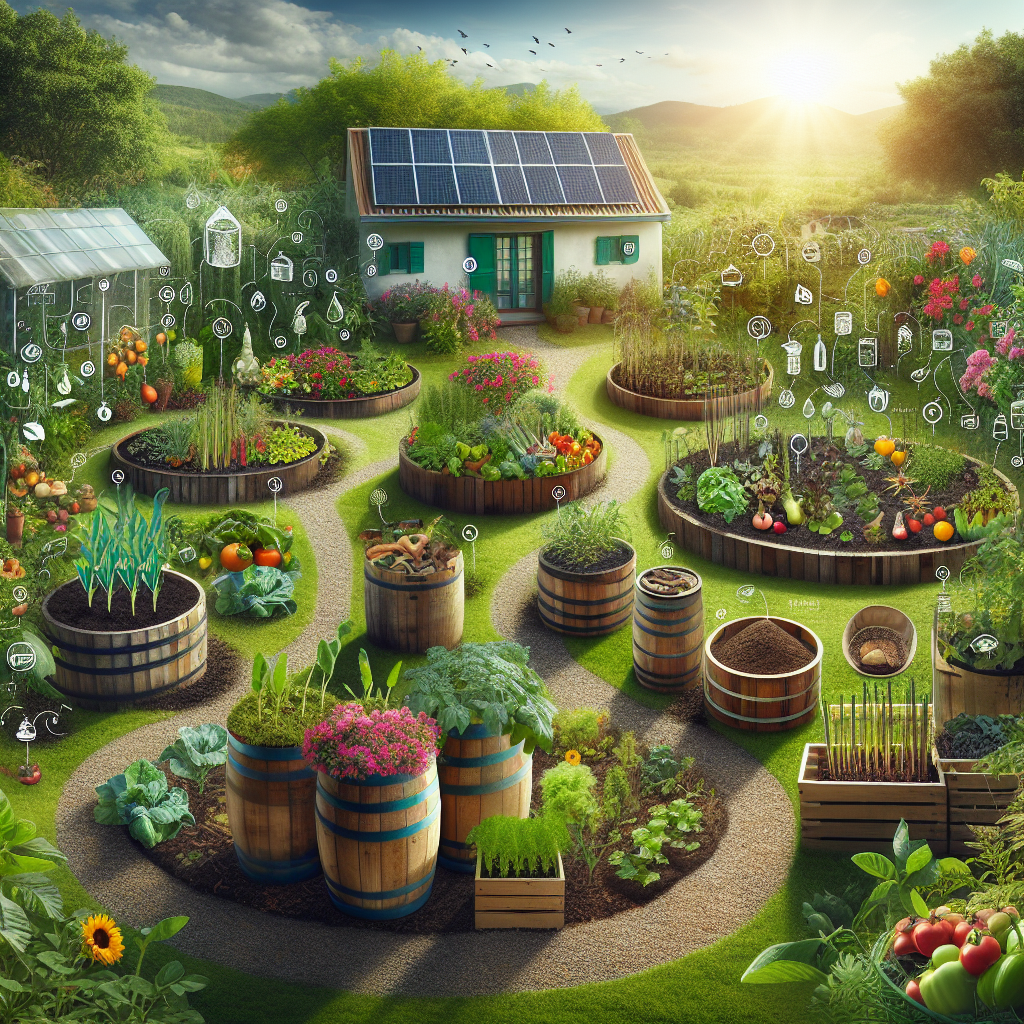A Comprehensive Beginners Guide to Permaculture: Start Your Sustainable Journey Today

Are you ready to dive into the world of sustainable living? Permaculture is a way to grow food and care for the earth at the same time. This guide will help you understand the basics, plan your first garden, and learn how to keep it thriving. Let's start your journey to a greener, more sustainable lifestyle!
Key Takeaways
- Permaculture combines gardening with caring for the environment.
- Planning is essential for a successful permaculture garden.
- Healthy soil and composting are the foundation of a thriving garden.
- Water management techniques can save resources and boost plant growth.
- Including animals in your system can enhance your garden's productivity.
Understanding the Basics of Permaculture
What is Permaculture?
Permaculture is a way of gardening that focuses on working with nature rather than against it. The term comes from the words permanent and agriculture. It aims to make growing food easier and more sustainable by creating a self-sustaining ecosystem. Unlike traditional gardening, permaculture emphasizes the importance of natural processes and biodiversity.
Core Principles of Permaculture
Permaculture is built on several core principles that guide its practice:
- Observe and Interact: Take the time to understand your environment and work with it.
- Catch and Store Energy: Use resources like rainwater and sunlight efficiently.
- Obtain a Yield: Ensure that your efforts result in useful outputs, like food or energy.
- Apply Self-Regulation and Accept Feedback: Adjust your methods based on what works and what doesn't.
- Use and Value Renewable Resources: Prioritize resources that can be replenished naturally.
- Produce No Waste: Make use of every resource and recycle whenever possible.
- Design from Patterns to Details: Start with a broad plan and refine it as you go.
- Integrate Rather than Segregate: Combine elements to support each other.
- Use Small and Slow Solutions: Start small and scale up as you learn.
- Use and Value Diversity: Encourage a variety of plants and animals to create a resilient system.
- Use Edges and Value the Marginal: Make the most of the edges and fringes in your garden.
- Creatively Use and Respond to Change: Be adaptable and open to new ideas.
Benefits of Permaculture for Beginners
Starting a permaculture garden has many benefits, especially for beginners:
- Low Maintenance: Once established, permaculture gardens require less upkeep than traditional gardens.
- Higher Yields: By working with nature, you can often produce more food in less space.
- Sustainability: Permaculture practices are designed to be environmentally friendly and sustainable.
- Biodiversity: Encouraging a variety of plants and animals helps create a balanced ecosystem.
- Resilience: A diverse garden is more likely to withstand pests, diseases, and extreme weather.
Permaculture is more than just a gardening method; it's a way to live in harmony with the environment. By starting your own permaculture garden, you're taking a step towards a more sustainable and fulfilling lifestyle.
Designing Your First Permaculture Garden
Site Assessment and Planning
Before you start planting, it's crucial to understand your garden's unique characteristics. Assessing your site involves observing sunlight, wind patterns, and soil type. Take note of any slopes or water flow areas. This information will help you plan a garden that works with nature, not against it.
Creating a Permaculture Design
With your site assessment in hand, you can start designing. Sketch out your garden layout, considering zones for different plant types and activities. Think about how you can use natural elements like trees for shade or windbreaks. Remember, a good design is both functional and beautiful.
Choosing the Right Plants
Selecting the right plants is key to a thriving permaculture garden. Choose native species and plants that support each other. For example, plant nitrogen-fixing plants near vegetables to enrich the soil. Diversity is your friend here, as it helps create a resilient ecosystem.
Starting a permaculture garden is a comprehensive guide to starting a sustainable garden using permaculture principles. Learn the basics, choose the right location, and educate others for a greener tomorrow.
Soil Health and Composting
Building Healthy Soil
Healthy soil is the foundation of any successful garden. By focusing on soil health, you can ensure your plants get the nutrients they need. Start by testing your soil to understand its composition. Add organic matter like compost to improve soil structure and fertility. Healthy soil is teeming with life, from earthworms to beneficial bacteria, all working together to support plant growth.
Composting 101
Composting is a simple way to recycle kitchen scraps and yard waste into nutrient-rich soil. Set up a compost bin in a shady spot and add a mix of green (nitrogen-rich) and brown (carbon-rich) materials. Turn the pile regularly to speed up decomposition. In a few months, you'll have dark, crumbly compost ready to enrich your garden soil. Composting not only reduces waste but also enhances soil health.
Natural Fertilizers and Amendments
Instead of relying on chemical fertilizers, opt for natural alternatives to boost your soil's fertility. Manure, bone meal, and fish emulsion are excellent choices. These natural fertilizers release nutrients slowly, providing a steady supply to your plants. Additionally, consider using cover crops to add organic matter and improve soil structure. Embracing natural amendments is a key step in building a sustainable garden.
Remember, healthy soil is the cornerstone of a thriving garden. By focusing on soil health and composting, you're setting the stage for a bountiful harvest and a sustainable gardening practice.
Water Management Techniques
Rainwater Harvesting
Rainwater harvesting is a fantastic way to make the most of natural resources. By collecting rainwater, you can reduce your dependence on municipal water supplies. This book offers practical insights into how farmers can redesign their land to capture, store, and utilize water more efficiently. Setting up a rainwater harvesting system can be as simple as placing barrels under your downspouts or as complex as installing an underground cistern.
Efficient Irrigation Systems
Efficient irrigation systems are crucial for conserving water while keeping your garden lush. Drip irrigation and soaker hoses are excellent choices because they deliver water directly to the plant roots, minimizing evaporation and runoff. These systems not only save water but also ensure that your plants get the moisture they need to thrive.
Greywater Recycling
Greywater recycling involves reusing water from sinks, showers, and washing machines for irrigation. This method can significantly reduce your water usage. By setting up a greywater system, you can redirect this water to your garden, providing a sustainable water source for your plants. It's a great way to make your home more eco-friendly and resource-efficient.
Water management is a key aspect of permaculture, helping you create a sustainable and self-sufficient garden. By implementing these techniques, you can conserve water, reduce costs, and support a healthier environment.
Integrating Animals into Your Permaculture System
Benefits of Livestock in Permaculture
Adding animals to your permaculture setup can bring many benefits. They help with pest control, provide natural fertilizer, and can even help with tilling the soil. Livestock can make your garden more productive and sustainable. Plus, they can offer a source of food, like eggs or milk, making your system even more self-sufficient.
Choosing the Right Animals
When picking animals for your permaculture garden, think about your space and needs. Chickens are great for small areas and are excellent at pest control. Ducks can help with slug problems, while goats are good for managing weeds. Each animal has its own role, so choose the ones that fit your ecosystem best.
Managing Animal Systems
Taking care of animals in a permaculture system requires planning. Make sure they have enough space, food, and water. Rotate grazing areas to prevent overuse and allow the land to recover. Keep an eye on their health and well-being to ensure they thrive. Happy, healthy animals will contribute more effectively to your permaculture garden.
Remember, wildlife plays an enormous role in permaculture. Where ecosystems are healthy, we find diversity. When diversity is threatened, so are the systems which support it. Integrating animals thoughtfully can help maintain this balance.
Maintaining and Evolving Your Permaculture Garden

Seasonal Maintenance Tips
Keeping your permaculture garden thriving year-round involves some seasonal care. Regularly check your plants for signs of stress or disease, and address issues promptly. In spring, focus on planting and mulching. Summer is all about watering efficiently and managing pests. Fall is the time to harvest and prepare your garden for winter by adding compost and cover crops. Winter is perfect for planning and making any necessary repairs.
Adapting to Changes
Nature is always changing, and your garden should too. Be ready to adapt your garden design based on what you observe. If a particular plant isn't thriving, don't be afraid to replace it with something more suitable. Keep an eye on weather patterns and be prepared to adjust your watering schedule or add protective measures during extreme conditions.
Continuous Learning and Improvement
Permaculture is a journey of continuous learning. Stay curious and keep educating yourself about new techniques and ideas. Join local permaculture groups or online forums to share experiences and gain insights. Remember, every garden is unique, so what works for one might not work for another. Embrace the process and enjoy the evolution of your sustainable garden.
Conclusion
Starting your journey into permaculture can feel like a big step, but it's one that's filled with promise and potential. By embracing sustainable practices, you're not just growing a garden—you're cultivating a healthier planet and a more self-sufficient lifestyle. Remember, every small effort counts. Whether you're planting your first seed or designing a whole ecosystem, each action contributes to a greener future. So, roll up your sleeves, get your hands dirty, and enjoy the rewarding experience of permaculture. Happy gardening!
Frequently Asked Questions
What is permaculture?
Permaculture is a way of designing gardens and farms to be sustainable and in harmony with nature. It focuses on using natural resources wisely and creating systems that can support themselves.
What are the main principles of permaculture?
The core principles of permaculture include observing and interacting with nature, capturing and storing energy, obtaining a yield, and using and valuing renewable resources. It's about working with nature, not against it.
How do I start a permaculture garden?
Begin by assessing your site and planning your garden layout. Create a design that includes a variety of plants, animals, and water management techniques. Start small and expand as you learn more.
What plants are best for a permaculture garden?
Choose plants that are native to your area and suited to your climate. Mix perennials and annuals, and include plants that support each other, like companion planting. Diversity is key.
How important is soil health in permaculture?
Soil health is crucial in permaculture. Healthy soil supports plant growth, retains water, and reduces the need for chemical fertilizers. You can improve soil health through composting and using natural fertilizers.
Can animals be part of a permaculture system?
Yes, animals can play a significant role in permaculture. They can help with pest control, provide manure for compost, and even assist in tilling the soil. Choose animals that fit well with your garden's needs and your ability to care for them.
